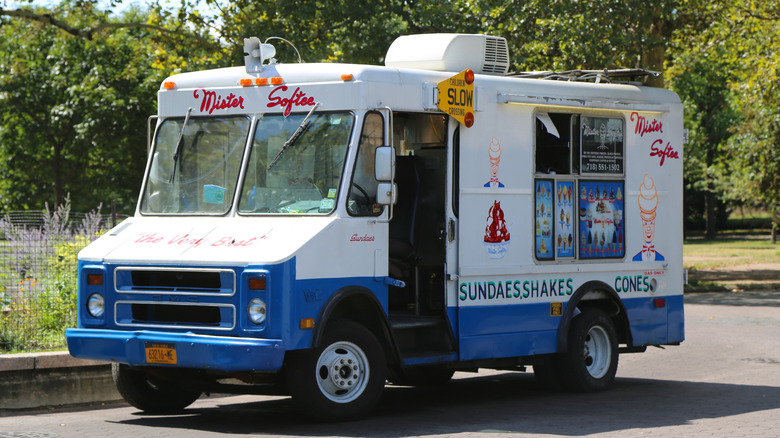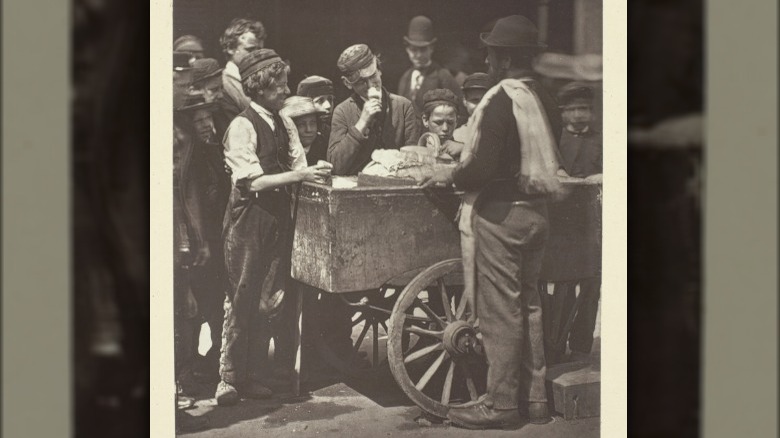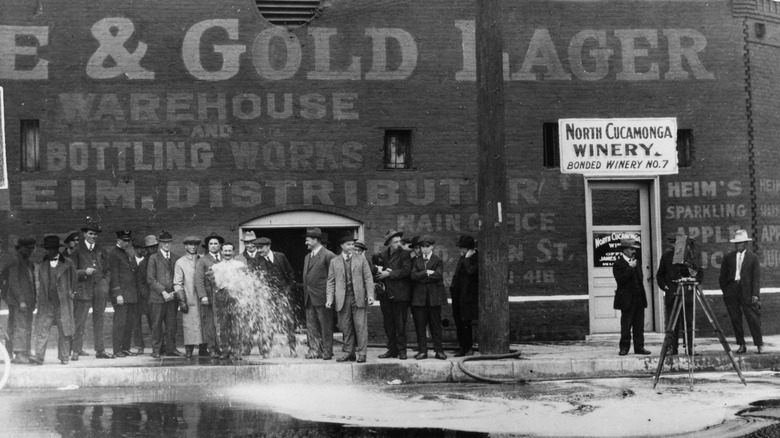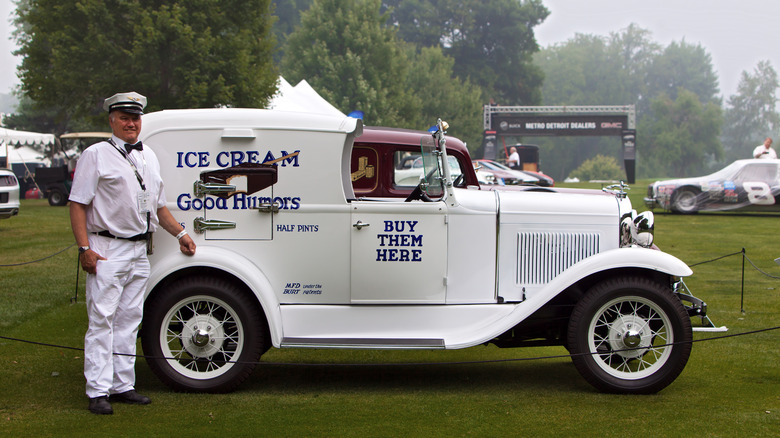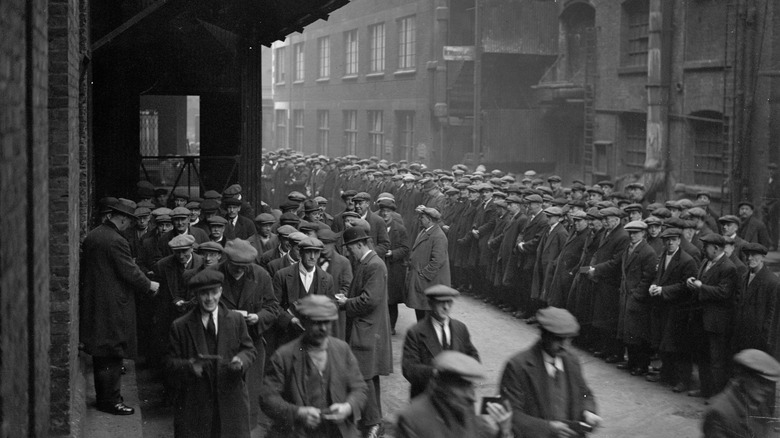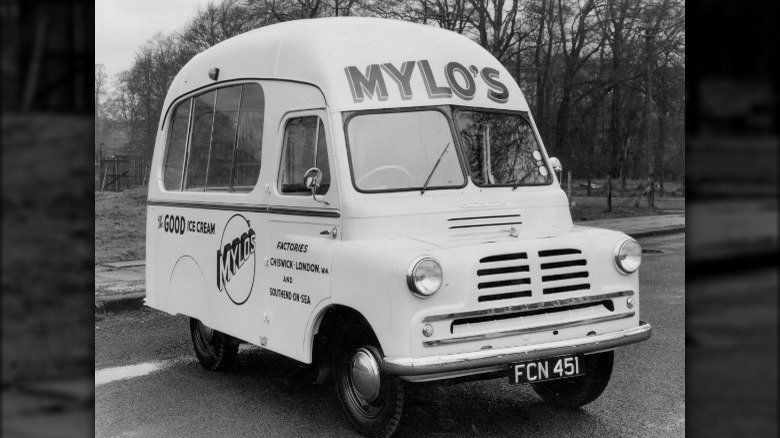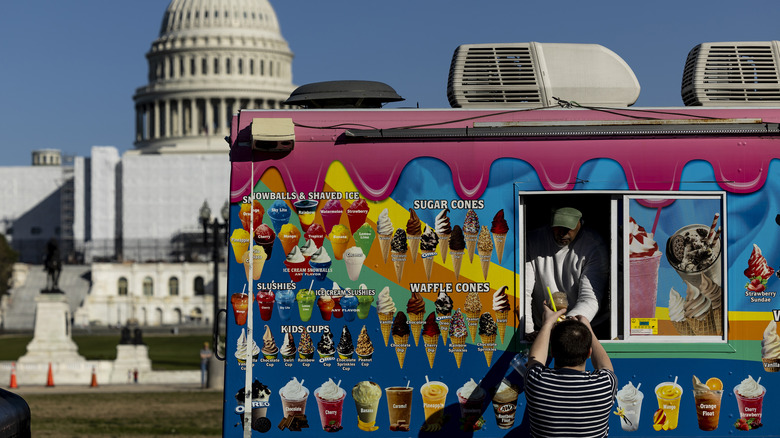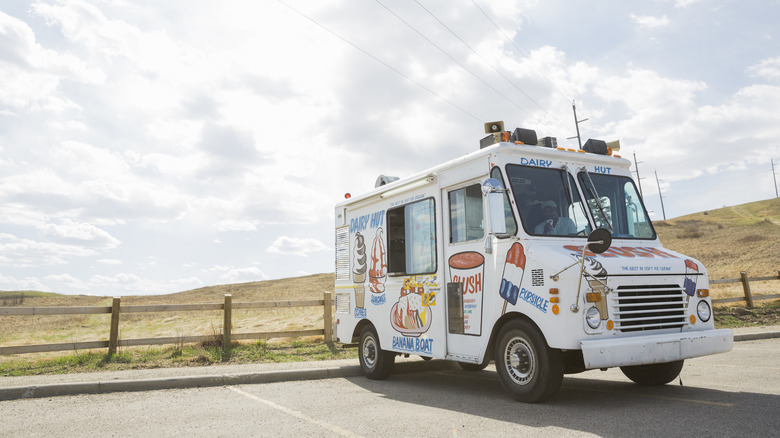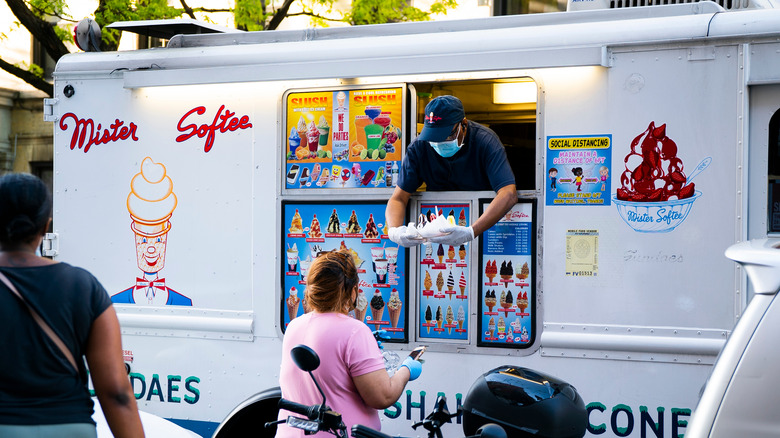The Unexpected History Of The Ice Cream Truck
Most dessert aficionados absolutely love ice cream, and it is easy to understand why. With countless varieties, we all scream for ice cream no matter what our favorite flavor is. While ice cream is readily available in supermarkets, restaurants, and local ice cream parlors, there's another business model that you may have grown up pining for each summer: the ice cream truck.
After all, why should you go out and buy ice cream when the ice cream comes to your neighborhood every day? A hot summer day isn't complete until you hear those recognizable jingles with their chime-like quality growing louder and louder as the truck rounds the corner. You scramble for a couple of dollars and you race out with everyone else, waiting your turn to buy your favorite frozen treat.
It's a favorite childhood memory that you get to relive as your own children start their own daily race for the local truck. But what you may not realize is that the history of the ice cream truck goes back much further than you might expect. The earliest models of street vendor ice cream sales happened well before trucks were even conceivable. If you've ever wondered what the history of the ice cream truck is like, we've got you covered like the chocolatey coating of a Good Humor bar.
It first began on foot
The concept of selling ice cream out on the street predates motorized vehicles. Ice cream and America go all the way back to the earliest colonizers, but the business model of actually delivering ice cream to customers came about in the 1800s. Without the capability of packing ice cream into a truck at the time, vendors first started selling their products on foot. It was a common work opportunity in the early 1800s for immigrants arriving in the United States to sell frozen treats out of push carts.
Some of the earliest examples of frozen street food included what was known as hokey-pokey, which was a Neapolitan-striped treat conveniently cut into small pieces and wrapped in paper for easy transportation. Others, like penny licks, involved ice cream being served in small, glass cups that the customer would return to the vendor to fill for the next buyer. Ice cream sandwiches were also a big hit for customers.
It was not all that safe to eat in the beginning
These days, ice cream trucks are known for serving individually-wrapped frozen treats or ice cream dispensed from soft-serve machines that are monitored for cleanliness and sanitation. Historically, that wasn't the case. One of the earliest ice cream treats, the penny-lickers, involved serving ice cream in a glass cup that customers would lick the ice cream out of. Once the glass was licked clean, it would be returned to the vendor. When a new customer arrived to make a purchase, the glass cup was rinsed in a single pail of water. As you might imagine, simply rinsing a glass cup that someone previously licked clean with their mouth is not the most sanitary of practices.
Also, the milk used to make ice cream wasn't pasteurized until the late 1800s. This meant any ice cream sold before that time had a high risk of being contaminated with disease-causing bacteria. In fact, ice cream poisonings were quite common, so it's kind of a marvel that the frozen novelties remained popular enough to stand the test of time.
An invention at the World's Fair changed the game for how ice cream was served
The earliest ice cream treats sold from street vendors had one major challenge: There was no easy way to hold your frozen snack. Given that ice cream melts, it's not like you can hold it in your empty hand — some sort of additional apparatus is necessary. The aforementioned paper-wrapped hokey-pokey and the unsanitary glass cup-delivered penny lick were the earliest options (remember: disposable cups also weren't yet invented). The solution to this problem — one that revolutionized the concept of street vendor ice cream, came about at the World's Fair.
The earliest known appearance of the ice cream cone was in the late 1800s, but the concept would be popularized at the 1904 World's Fair. It was brought about by Ernest Hamwi, who would later go on to be recognized as the official inventor. The invention truly changed the game when it came to ice cream, as hungry customers could now take their frozen treats to go.
Prohibition helped ice cream rise in popularity
While ice cream was becoming more popular in the early 1900s, so was the roaring lifestyle of shorter hair, flapper-style dresses, and Gatsby-esque parties. By the start of the 1920s, America was already in the midst of the Prohibition era which banned the manufacturing and sale of alcoholic beverages. With booze going underground, both metaphorically and literally, consumers had to turn to other indulgences to keep their spirits up (so to speak).
Ice cream became a sought-after respite, and frozen treats rose in popularity. In addition to ice cream's ability to satiate the appetites of temptation-seeking adults, Prohibition also gave rise to more soda shops, which commonly sold ice cream. So, instead of rum and Coke, people were ordering ice cream floats instead. By the time Prohibition was lifted in the early 1930s, families across America were fully inundated with (and fully enamored by) ice cream.
The first ice cream truck appeared in Youngstown, Ohio
During Prohibition in the 1920s, people were seeking new ways to satisfy the urge to go out and enjoy a special treat with their friends. Many turned to soda shops for ice cream and other novelties. But what about taking the ice cream out on the road? The answer came in Ohio. Harry Burt, a candy maker and confectioner by trade, developed a portable ice cream treat that was soon known as the classic Good Humor bar. Burt immediately had the idea to take his creation to the streets to sell to hungry customers with a rising appetite for ice cream.
Burt acquired 12 trucks outfitted with refrigerators to sell his Good Humor bars — the first known fleet of ice cream trucks. Burt's trucks were originally intended for distribution in the Youngstown, Ohio area, each staffed by "chauffeurs," or a driver wearing a white uniform.
Ice cream's low cost meant it could endure the Great Depression
By 1930, the United States had plummeted into the Great Depression, an era that spurred massive waves of unemployment and, as a result, tight spending among families. In any economic downturn, spenders have to reevaluate what they can afford on a day-to-day basis, and some higher-priced luxuries, or even more costly necessities, have to be put on the back burner. But, surprisingly, ice cream not only survived the Great Depression, but the industry proved to be a successful business model for some during that time.
Being a commissioned driver for Good Humor in the 1930s paid approximately $100 per week which, when accounting for inflation, amounted to over $1,800 per week as of 2020. That's pretty solid earnings, especially during a depression when so many were unemployed. The comfortable earnings were largely attributed to how successful ice cream sales were during that time, with 14 million Good Humor bars sold in just one year in New York and Chicago.
Post-World War II ice cream production was on the rise
It was only a matter of time before new companies joined in on the ice cream truck phenomenon and Good Humor saw some legitimate competition. The post-World War II boom in the economy manifested in all kinds of business sectors, and ice cream was no exception. Good Humor themselves expanded their fleet of trucks to over 2,000, and a number of new companies entered the fold to try their hand at the business, including Mister Softee, which began operation in 1956.
Mister Softee was founded in Philadelphia by brothers William and James Conway. The way Mister Softee was able to differentiate itself from Good Humor was that, instead of ice cream bars, it sold soft-serve ice cream, sundaes, and milkshakes. Revolutionary, yes, but also a challenge to what the traditional ice cream truck was at the time. Freezers were no longer sufficient, and the trucks needed to be fitted with soft-serve machines. But once the business model was up and running, there was no looking back. It didn't take long for Mister Softee to expand, and within five years the company was stationing trucks across the country.
The products sold out of ice cream trucks have evolved
Fast forward to today, and ice cream trucks are still a vital part of what makes summer so memorable. No matter how old you are, the sound of the familiar ice cream truck jingle will make you wonder if you have any spare cash laying around ... and if you can run outside in time to catch the truck. While many things have remained the same, ice cream itself has evolved over the years.
Classic ice cream treats remain undefeated with ice cream sandwiches and Firecrackers (the red, white, and blue Popsicle) still reigning supreme. But in addition to ice cream truck mainstays, various characters from pop culture have made appearances on ice cream truck menus, including Batman, Spiderman, and SpongeBob SquarePants — complete with unsettling gumball eyes. As with any successful business model, it changes and grows with the culture, and ice cream trucks are no exception.
Ice cream truck jingles have changed over the years
Perhaps one of the most memorable aspects of an ice cream truck are the iconic jingles that play as it makes its way down the street. Sounds have always accompanied the vehicles, with sleigh bells acting as the first melodic voice of the Good Humor trucks. The bells were eventually ditched for pre-recorded music, thanks to a Good Humor franchisee in Los Angeles. But over the years, the industry has had to come to terms with the problematic roots of one of the most recognizable and widely-used ice cream truck tunes, "Turkey in the Straw." The song itself has a history longer than that of the ice cream truck, and it was originally chosen as a then-popular tune that kids would recognize as the trucks approached.
In an effort to make the experience of ice cream trucks more inclusive, Good Humor teamed up with Wu-Tang Clan founder Robert Fitzgerald Diggs (also known as RZA) in 2020 to produce a new jingle that the trucks can use for free. The new track joins a lineup of other catchy ice cream truck jingles that instantly summon an entire neighborhood out onto the streets each summer.
Ice cream trucks deemed themselves as an essential business during the COVID-19 pandemic
When the COVID-19 pandemic roared into the United States in March 2020, businesses across the country were forced to close their doors. Some stores and industries, however, remained open as they were considered necessary and essential to the country's structural functioning. As the balancing act between remaining safe and returning to daily life began to allow families to move about more freely, more and more essential businesses started to be identified.
When New York State recognized food trucks as essential businesses in 2020, it did not initially include ice cream trucks. But that did not stop several Mister Softee trucks from selling ice cream. In an interview in April 2020 with ABC 7 NY, Mike Conway, vice president at Mister Softee, admitted it was impossible to control the fleet of trucks, but noted "I think getting ice cream is not going to be essential at this time." It is certainly hard to imagine life without ice cream, and the drivers who chose to remain in business in 2020 did so while adhering to guidelines passed along by the company.
The future of ice cream trucks looks sweet
For a business model that has been around for roughly two centuries, there is still something to be said for the nostalgia and the novelty of buying ice cream from a truck. So, it certainly doesn't look like ice cream trucks are going anywhere anytime soon. In fact, the industry is adopting new, modern ways of improving the business model, as well as the trucks themselves. For example, in 2019 Nissan unveiled a zero-emission van called "Sky to Scoop," specifically designed to operate as an ice cream truck.
The growth of the ice cream truck industry has not been without its challenges. In an interview with the Washingtonian, Hamidu Jalloh, a 25-year veteran of the ice cream truck industry, shared that he's noticed increased competition from businesses that acquire freezers to sell their own ice cream. But it is hard to compete with the thrill of an ice cream truck coming down your street, and if history is any indicator, kids and adults will continue to enjoy their ice cream sandwiches or soft serve for years to come.
